
Original Link: https://www.anandtech.com/show/5769/dell-precision-t3600-review-dells-new-enterprise
Dell Precision T3600 Review: Dell's New Enterprise
by Dustin Sklavos on April 23, 2012 7:00 AM EST- Posted in
- Systems
- Dell
- Precision
- Workstation
- Maximus
Introducing the Dell Precision T3600
As far as enterprise-class workstations go, we're at the point now where there are fundamentally two major competitors: an entrenched HP, and a very hungry Dell. We've had a couple of HP workstations in for review already (and more on the way), but today we're taking a look at one of the entries in Dell's substantially revamped Precision line.
Dell has completely rejiggered the designs of their Precision workstation towers. While the performance is going to be what you'd expect since HP and Dell are still fundamentally pulling from the same pool of high-performance hardware from Intel and NVIDIA, build and design are where Dell is really looking at distinguishing themselves from the competition with their new Precision line.
.jpg)
With all that said, though, that doesn't mean the underlying hardware isn't interesting. Intel's Sandy Bridge-E-based Xeon processors are on the market now, and NVIDIA continues to push Fermi for their high-end workstation graphics. Up until this point we've had mostly entry level cards in the workstations we've reviewed, so it's a nice change of pace to get a beefier machine in.
| Dell Precision T3600 Specifications | |
| Chassis | Dell Custom |
| Processor |
Intel Xeon E5-2667 (6x2.9GHz + HTT, Turbo to 3.5GHz, 32nm, 15MB L3, 130W) |
| Motherboard | Dell Custom with C600 Chipset |
| Memory | 4x2GB Hynix ECC DDR3-1333 (max 4x16GB) |
| Graphics |
NVIDIA Quadro 4000 (256 CUDA cores, 475MHz/950MHz/2.8GHz core/shaders/memory, 256-bit memory bus) |
| Hard Drive(s) | 2x Samsung HD256GM 256GB 10K-RPM SAS HDDs in RAID 0 |
| Optical Drive(s) | HL-DT-ST Slimline DVD-RAM |
| Power Supply | Dell Custom 80 Plus Gold |
| Networking | Intel 82579LM Gigabit Ethernet |
| Audio |
Realtek ALC269 Speaker and mic/line-in jacks |
| Front Side |
Optical drive 3x USB 2.0 1x USB 3.0 Headphone and mic jacks BIOS indicator lights |
| Top | - |
| Back Side |
Speaker and mic/line-in jacks Serial port 5x USB 2.0 1x USB 3.0 Ethernet jack PS/2 keyboard and mouse ports DVI-D (Quadro) 2x DisplayPort (Quadro) |
| Operating System | Windows 7 Professional 64-bit SP1 |
| Extras |
Externally removable, toolless 80 Plus Gold power supply USB 3.0 Toolless SAS drive bays Dell RMT technology Intel vPro |
| Warranty | 3-year parts and 3-year on-site service |
| Pricing |
Starting at: $1,099 Price as configured: $4,450 |
While Sandy Bridge-E didn't exactly set the enthusiast world on fire, in the workstation space it has a much more tangible impact. The Intel Xeon E5-2667 is a hex-core processor with 15MB of L3 cache, running at a nominal 2.9GHz but able to turbo up to 3.2GHz on all six cores or 3.5GHz on a single core. Attached to its integrated quad-channel memory controller are four sticks of 2GB Hynix DDR3-1333 ECC RAM for a total of 8GB, but this is one of the places where Dell leverages a feature unique to them called RMT, or Reliable Memory Technology.
Dell's RMT is impressive in that it works on top of the built-in error correction mechanisms inherent to ECC memory. Whenever there's a page fault, RMT will basically map where the bad page in the memory is and when the computer reboots it will prevent the system from using that page. As a result, the system maintains its uptime by working around the bad memory. Once there are seven or more faults in a single DIMM, the system will then suggest you replace that stick. Useful!
While our review system didn't come configured with SSDs, we did get a pair of Samsung 10,000-RPM hard drives running off of a SAS connection and configured in RAID 0. Dell offers a nice spread of storage options, starting at basic 7,200-RPM SATA hard drives and moving up to SSDs and 15K-RPM SAS drives.
Handling workstation graphics processing duties is the NVIDIA Quadro 4000, essentially the third-fastest workstation GPU NVIDIA offers. It's interesting to note that their top three are all basically die-harvested GF100 parts, but they also have substantially lower peak wattage than desktop-class Fermi cards do. The Quadro 4000 is particularly interesting because it's a GF100 with basically half of its CUDA cores disabled, leaving it with just 256 CUDA cores at its disposal. Its memory bus has also been reduced to 256-bit from 384-bit, and all of its clocks are comparatively low: 475MHz base clock, 950MHz on the CUDA cores, and the 2GB of GDDR5 runs at just 2.8GHz. At the same time, making these reductions allows the Quadro 4000 to function with a single slot cooler and a TDP of just 142 watts. While it doesn't initially make sense to pare down a GF100 this much, keep in mind that the chip itself is far more efficient at double-precision math than any of the consumer Fermi derivatives: NVIDIA rates it for 243.2 gigaFLOPs in double-precision, half of its single-precision throughput. Compare this to Kepler's GK104 or even Fermi's GF104/GF114, both of which take a swan dive once double-precision calculation is required.
Finally, in a welcome change of pace from the last generation of Precision workstations, the T3600 comes with an 80 Plus Gold, 90% efficient power supply standard. In our review of the T1600 we chastised Dell for cheaping out on the power supply, so we're happy to see that problem resolved in the new generation of Precision towers.
Obviously all this workstation class hardware doesn't come cheap. While the base model T3600 starts out at $1100, as configured our test system costs roughly four times as much. Just looking at online prices (e.g. not what Dell actually charges for the various upgrades), $750 of that is for the Quadro 4000, while the Xeon E5-2667 "only" costs over $1500 online. Ouch! We couldn't find any prices for the Samsung SAS drives Dell uses, but 300GB SAS 10K-RPM drives generally go for $300 or more depending on features, and the SAS controller card adds to the price as well. In other words, the price of workstation class hardware quickly adds up, but there's the promise of better service, support, and reliability to go along with the cost.
Peeking Inside the New Precision Line
Dell held a press event in San Francisco, California on Friday, April 20th to unveil their revised Precision line-up and featured guest speakers from both the mechanical engineering industries and the motion graphics industries as well as guests from NVIDIA and Intel. The new Precision line is a very big deal to Dell, and it's clear they went back to the drawing board after their last generation. When a big company like Dell is genuinely hungry for marketshare, the end users always benefit the most, and that seems to be the case with these new towers as Dell tries to claw more customers away from HP.
It's very easy to be cynical about a product launch where the vendor talks about how powerful their new system is, because in the strictest sense it's not really their hardware: it's the combination of hardware from other vendors that is so powerful. Fundamentally vendors use what's available, and what's available from Intel and NVIDIA right now is impressively powerful. That's especially true when you're talking about leveraging six- and eight-core processors based on Intel's Sandy Bridge-E architecture, and NVIDIA's Maximus and SLI technologies.
Where Dell is scoring big with the T3600, T5600, and T7600 towers is in the chassis design and in their Reliable Memory Technology secret sauce. Dell still doesn't have anything like HP's Performance Advisor on the software side, but RMT is arguably more valuable since uptime is in some cases even more critical than raw performance.
.jpg)
Each of the towers sports the same fundamentals in the chassis design. There are two large aluminum handles that make it easier to carry, but the top can also be removed and have rails attached so that the towers can be installed in a rack-mounted orientation. There's a direct front-to-back airflow design that takes advantage of tower-style coolers on the processor, allowing the system to be acoustically and thermally efficient while remaining stackable.
.jpg)
The interiors are also much, much cleaner than the previous generation, and drive bays are now toolless along with, get this, a toolless power supply. The PSU appears to be fundamentally modular but also a proprietary design (with all the pro's and con's associated with that); if the PSU in a system fails, you can actually pull it out of the back of the system then slide a new one in and have the system back up and running in under a minute, no rewiring required. While on the one hand this leaves you at Dell's mercy for getting replacement units, on the other hand the tremendous value in retained uptime and lack of service time may very well make up for it. Besides, when you're paying for enterprise class workstations, features like this are what makes a design better than the competition.
Recognizing that optical drives are becoming less and less important, Dell specced the new line with slimline drives instead of full-sized 5.25" drives. They maintained the 5.25" drive bay, though, and that allows the end consumer the flexibility of configuring the system with either an optical drive, a quad of 2.5" drive bays, or whatever else they might need in that bay. It's a nice touch.
Finally, as I mentioned on the previous page, Dell has their own patented technology called RMT, or Reliable Memory Technology, which maps and isolates bad memory pages whenever there's a page fault, allowing the end user to continue using the rest of the DIMM and thus maintaining precious system uptime. Only when a DIMM has seven or more faults will the system suggest that you outright replace the stick.
The differences between the four Precision lines (T1650, T3600, T5600, T7600) really can be broken down simply. The T1650 is the entry level, single-socket, average-powered system. The T3600 is the first step up; it supports the fastest graphics cards available as well as running dual GPUs, but remains a single-socket system. The next step up is the T5600, which switches over to a dual-socket configuration, offers four DIMM slots per socket, and is able to support two PCI Express graphics cards (or theoretically a GPU and an NVIDIA Tesla card for Maximus). Finally, the big daddy is the T7600, which features two sockets and eight DIMM slots per socket, with support for up to three PCI Express cards should end users choose to run SLI and/or Maximus.
System Performance
For performance testing with the Dell Precision T3600, we've elected not to include results from any systems not explicitly marketed as workstations (outside of the desktop i7-990X/GTX 580 system used solely as a reference point). Gaming results also aren't included; this isn't a gaming desktop and its strengths just aren't going to be exposed in games.
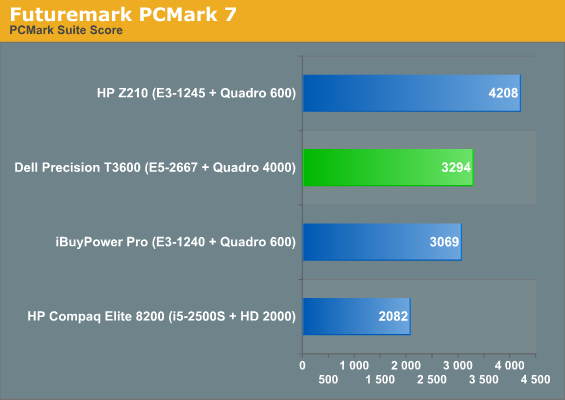
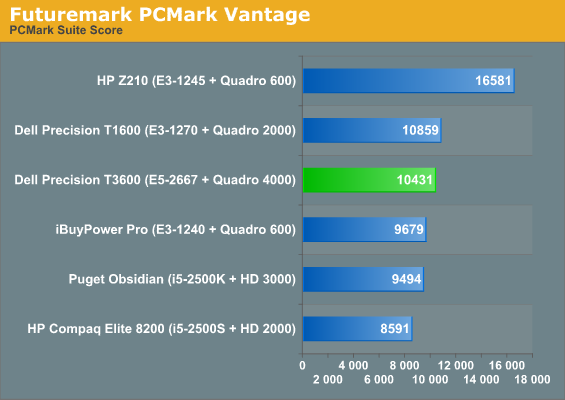
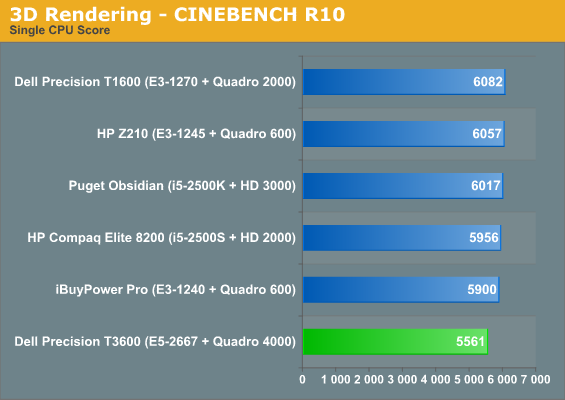
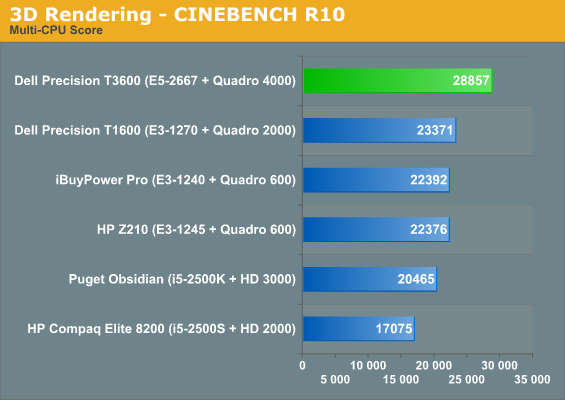
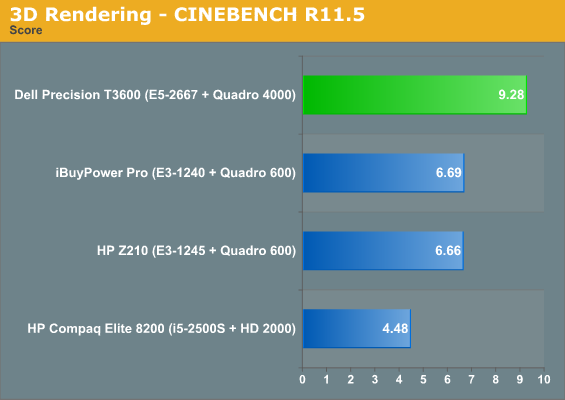
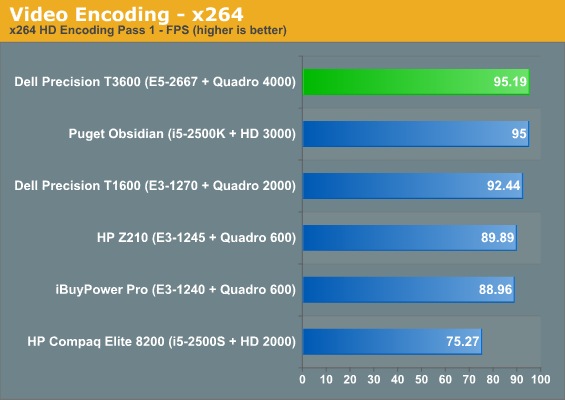
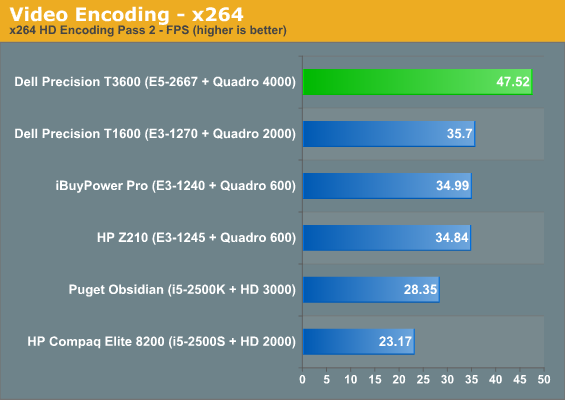
While the PCMarks favor HP's Z210 for its solid state drive, almost everything else has the Dell Precision T3600's hex-core processor screaming past the competition. Only the single-threaded performance in Cinebench R10 is a sore spot, but that's understandable; the E5-2667 can only hit 3.5GHz on a single core, less than even the i5-2500S which has a top speed of 3.7GHz. Anything that leverages multiple cores shows a major lead for the T3600.
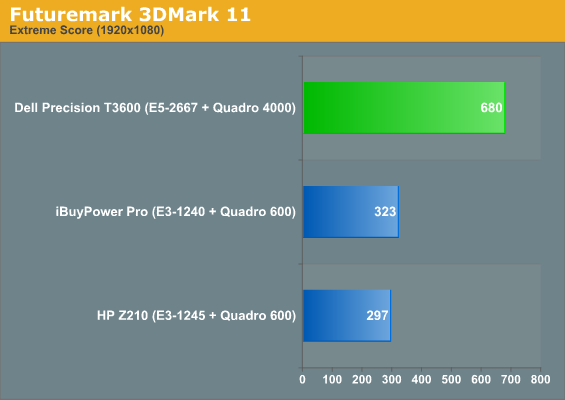
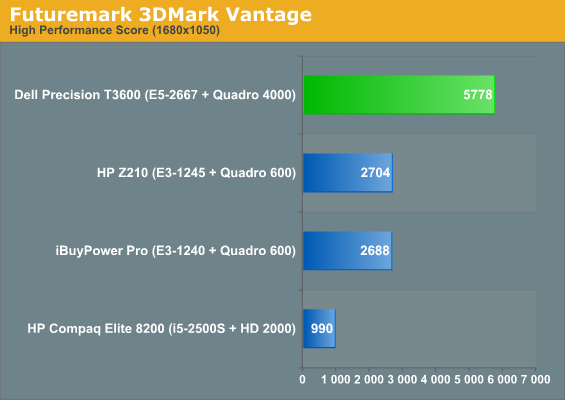
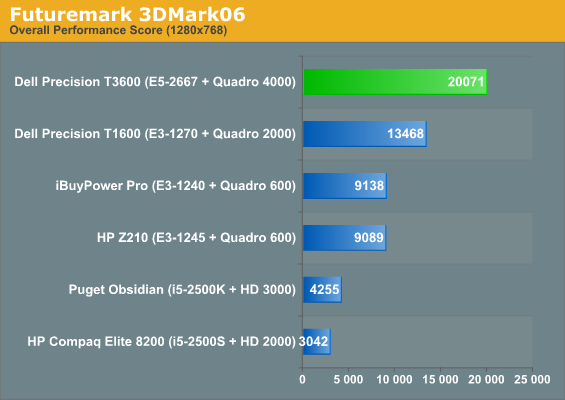
Our 3DMark tests also demonstrate that the NVIDIA Quadro 4000 in the T3600 is the fastest desktop workstation card we've yet had the opportunity to test. Note the distinction made, though: fastest desktop workstation card. You'll see on the following page there's still one faster GPU we've tested.
Workstation Performance
I've tried to stress this before but it really does bear repeating: workstation-class graphics cards, whether or not they share silicon with desktop parts a quarter of the price, pay for themselves in performance. The NVIDIA Quadro 4000 in the Dell Precision T3600 demonstrates that; as a gaming card it would be woefully underpowered, but as a workstation card operating in situations that leverage both the optimized OpenGL drivers and formidable double precision performance, it easily justifies itself.
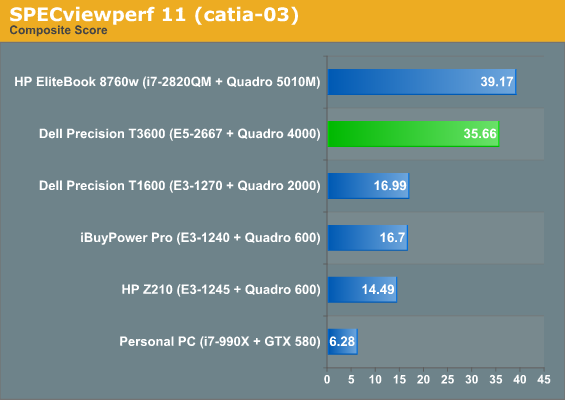
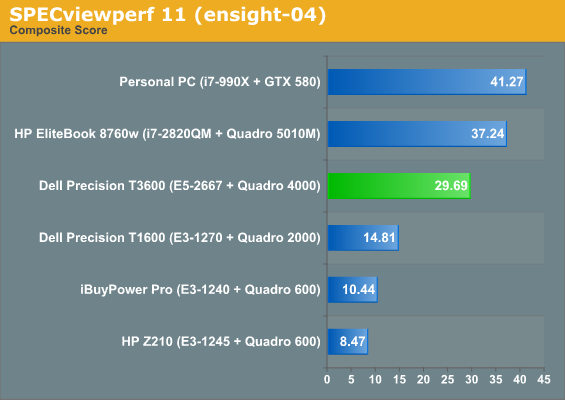
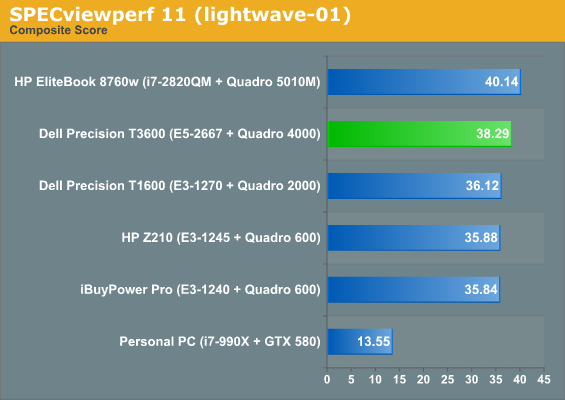
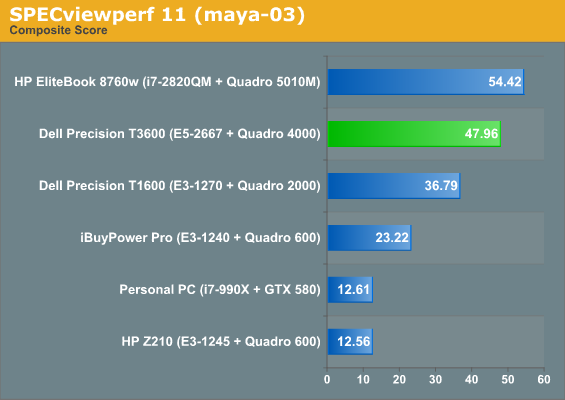
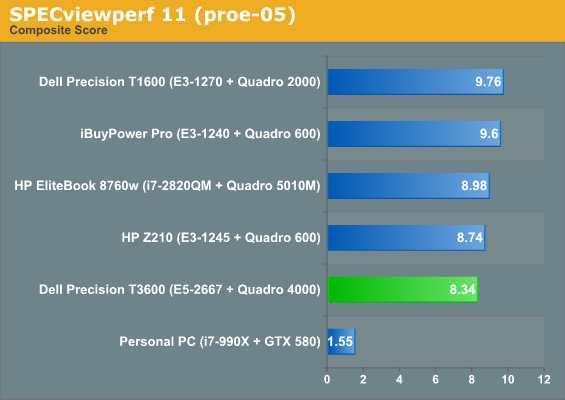
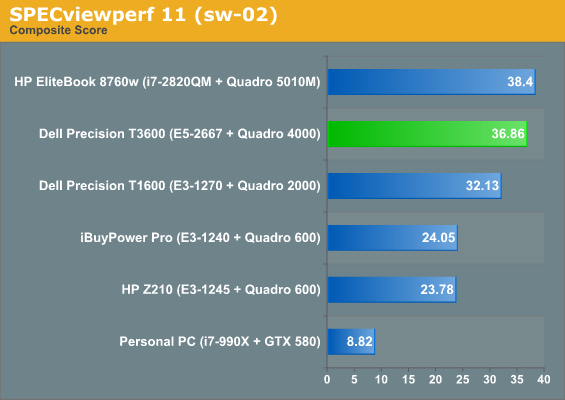
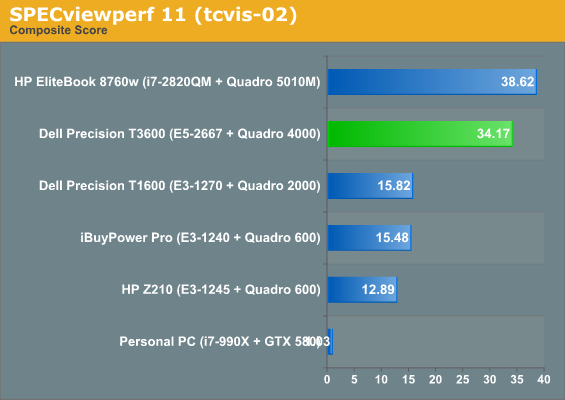
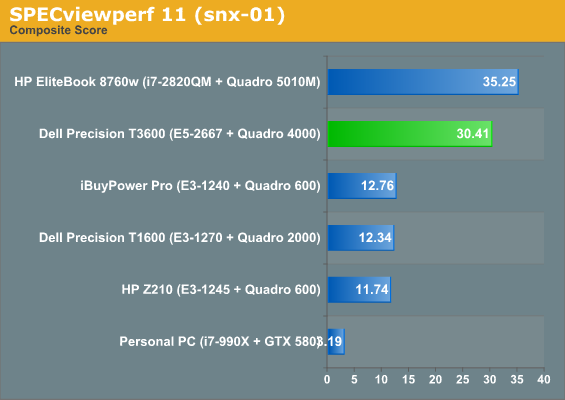
Notice how in most cases, the GTX 580 with a fully enabled Fermi core gets massacred by cards with half the shader power or less. The Quadro 5010M in the HP EliteBook 8760w is the only GPU that's able to consistently outperform the Quadro 4000, and that makes sense: it has similar clocks, but it boasts 128 more CUDA cores. It's also the fastest mobile workstation GPU available, bar none.
If I had to guess, I'd say that once desktop graphics limitations are taken out of the equation, the proe-05 test gets stuck on single-threaded CPU performance. Meanwhile ensight-04 is the only test that focuses on pure GPU performance and doesn't care about optimized drivers.
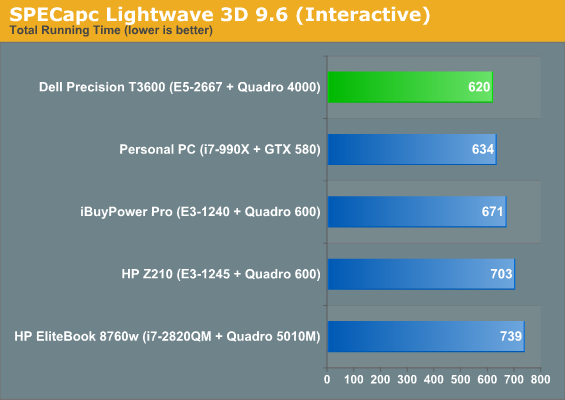
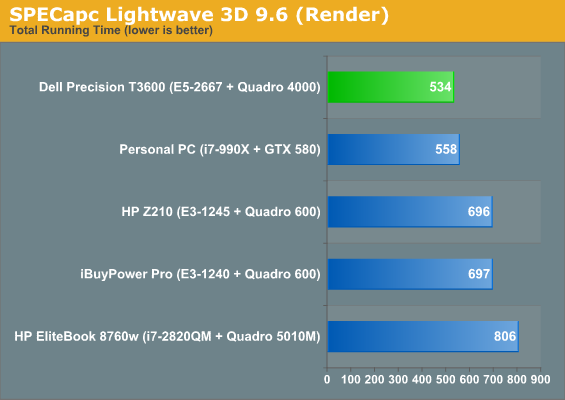
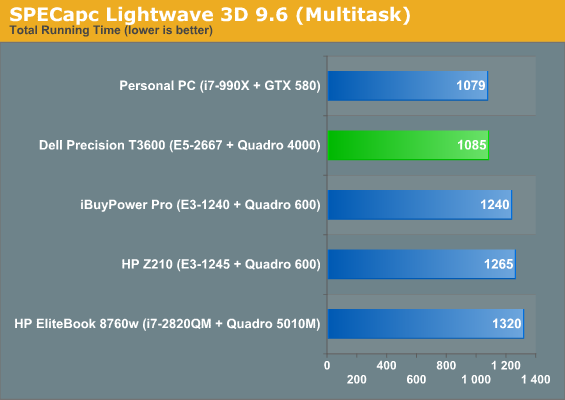
The Xeon E5-2667 runs at slightly lower clocks than the Core i7-990X, but it benefits from the more efficient Sandy Bridge-E architecture while the i7-990X makes do with Gulftown. Lightwave definitely wants the fastest CPU it can get, though, and the E5-2667 delivers.
Heat, Noise, and Power Consumption
Since we already addressed build quality previously when discussing the entire new Precision line-up, now we can see if the claims of both silence and improved thermal performance really hold up with Dell's Precision T3600.
As far as noise goes, the T3600 remains whisper quiet at idle and only really kicks up under extreme load. Even then, the fan noise is a very low rush that still remains below 40dB. Dell's guests spoke about how quiet the top of the line T7600 workstation was, but the T3600 is pretty stellar on its own.
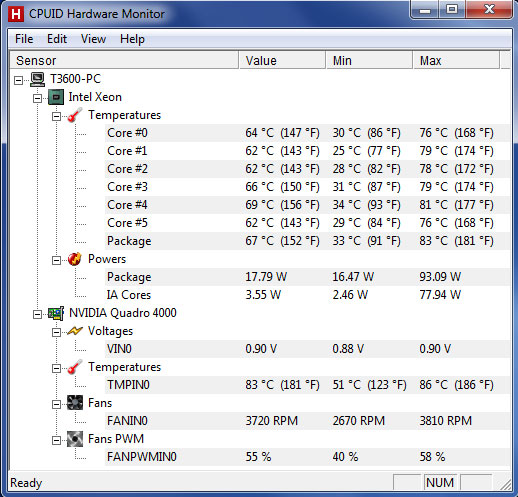
Thermally, though, there's a minor cost. It's clear Dell tuned the T3600 for silence rather than thermals, and while the heat isn't terrible (and is in fact well within spec), it's not perfect either. With that said, Dell's cooling system also seems to have a decent amount of headroom to it given how quietly it runs at these temperatures, so having a series of workstations rack-mounted probably won't be an issue so long as their exhausts aren't blocked.
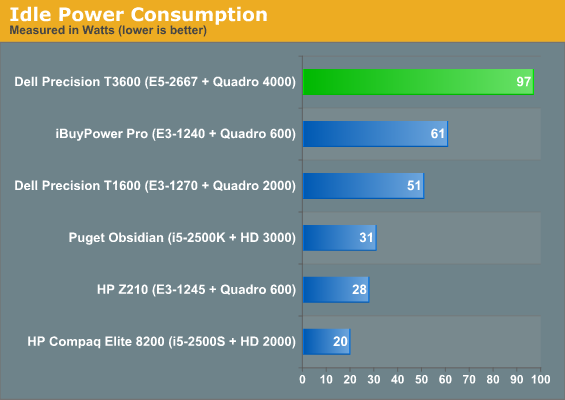
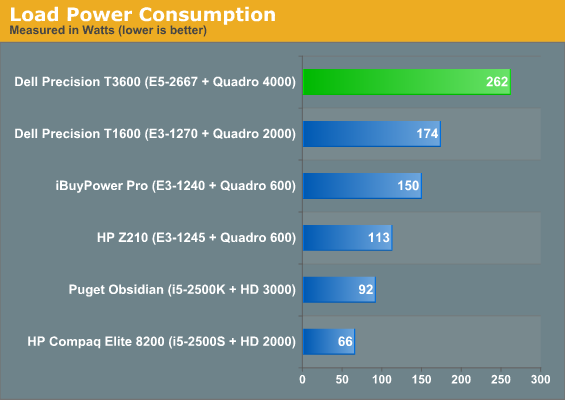
Finally, as the most powerful desktop workstation we've tested and the first one running enterprise-class Sandy Bridge-E hardware, the T3600 winds up pulling the most power from the wall. In perspective, however, the 97 watts of idle draw and 262 watts of full load power are still nowhere near what an enthusiast-class gaming system can pull. Despite the combined rated TDP of 272 watts (130W on the CPU and 142W on the GPU), the T3600 draws just 10 watts shy of that under stress.
Conclusion: Most Improved Since 2011
Where build and design are concerned, Dell's Precision T3600 (along with the T5600 and T7600) are like night and day compared to last year's line. The Precision T1600 wasn't a bad desktop, but the revised design here is preferable in every conceivable way, and those design cues are echoed across the entire lineup (including the new T1650).
While Dell would like to talk to you about performance and just how fast their Precision desktops are, realistically that's not actually their strong suit when taken in context. HP can for the most part build desktops just as fast as Dell can because they're sourcing their parts from the same places. The underlying mantra with Dell's revised chassis design, and the thing that the end user should really be focusing on, is one word: "uptime."
In a perfect world computer parts just wouldn't break down, but this isn't a perfect world, so Dell did the next best thing: they tried to make the least reliable parts in a computer system as easy to service as humanly possible. Their RMT addresses memory-related issues and stability while toolless mounts for hard drives and especially the power supply ensure that should any of these parts actually fail, it's easy to just replace it and keep going. Simply put, Dell has designed around minimizing downtime due to service. Better still, they've made the systems easy enough to service that even a relative neophyte can do it.
The other thing I'd ordinarily want to address with the T3600 would be pricing, but this review is as much a preview as it is a review. The T3600 and its kin aren't going to be available until next month, and so until then we have no idea just how badly the end user is going to get gouged—and rest assured, they will be gouged. This is as true for HP as it is for Dell; you're paying for service and reliability, and in the process you're going to pay an arm and a leg for certain upgrades. There's a very good reason companies chase after the enterprise sector.
Ultimately, though, I think Dell has done very right by their customers with the new Precision towers. The T3600, at least in our review configuration, is as fast as Dell wants you to believe. They've also made the systems as easy to diagnose and service as humanly possible. We have a competing system from HP in house that we'll be reviewing soon, but the bar has been set.

_thumb.jpg)
_thumb.jpg)
_thumb.jpg)
_thumb.jpg)
_thumb.jpg)
_thumb.jpg)












